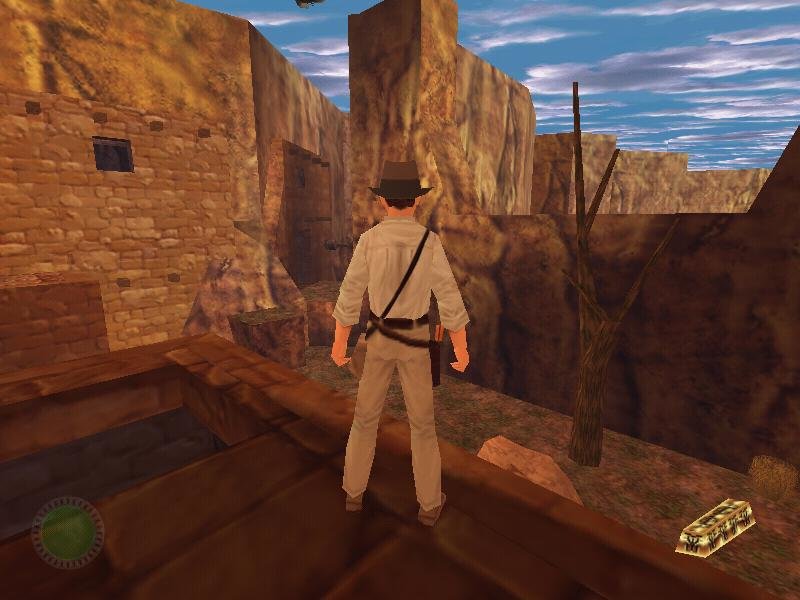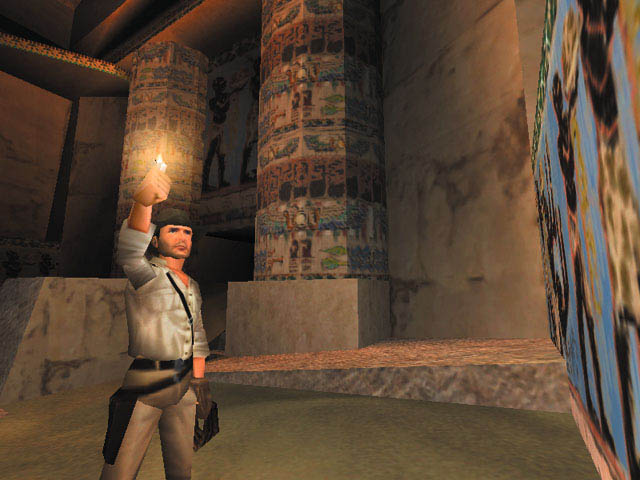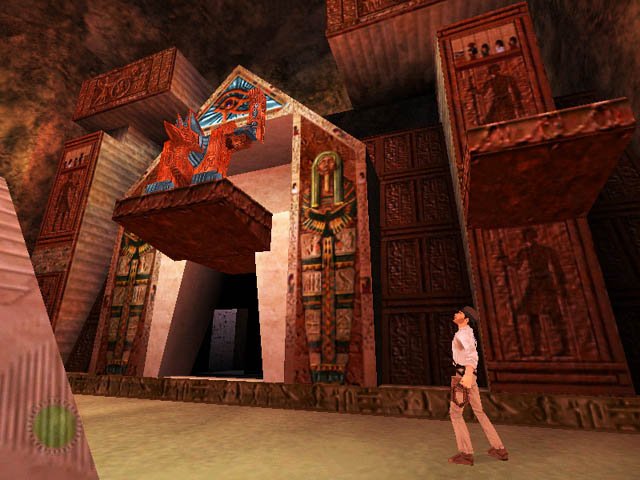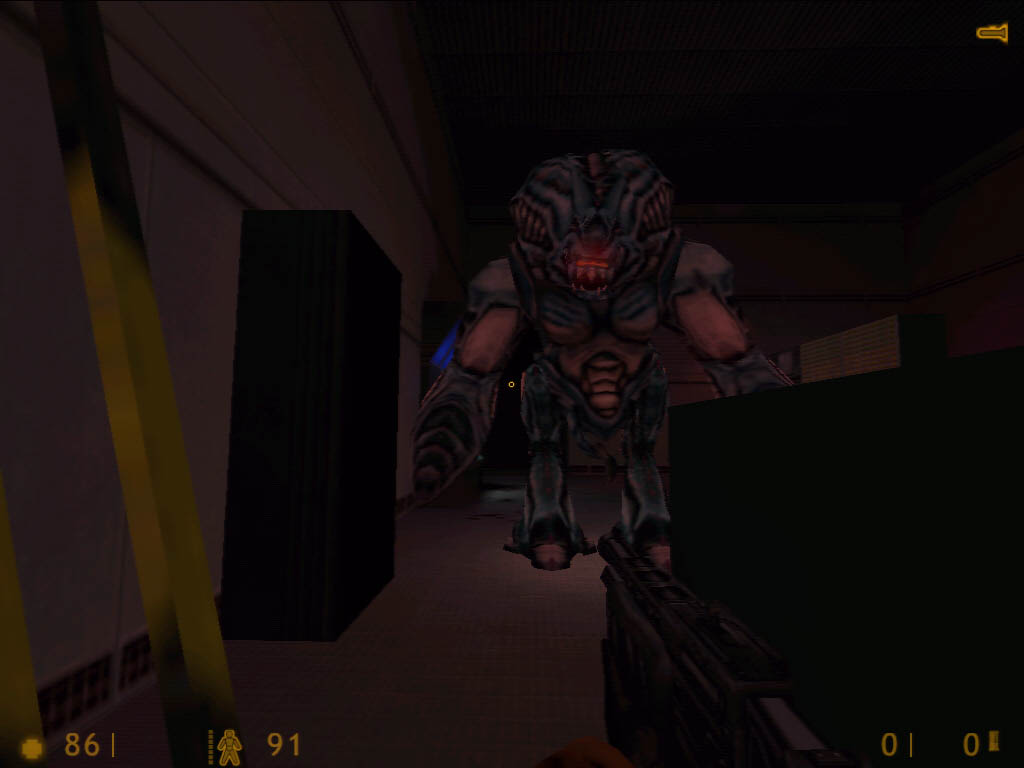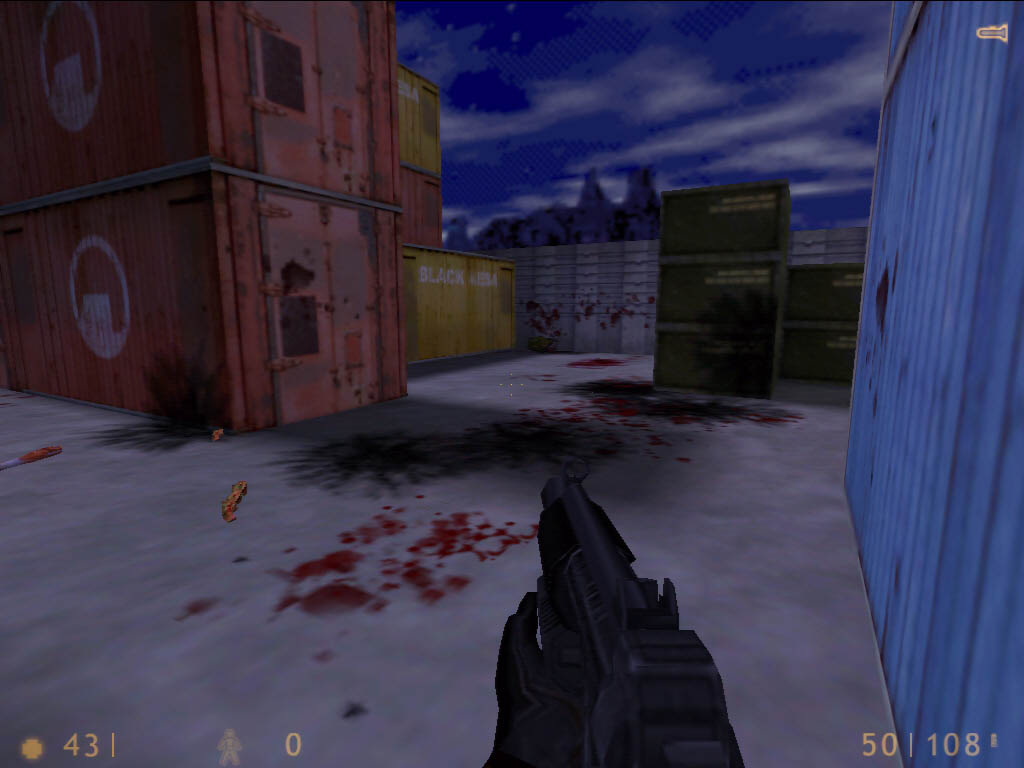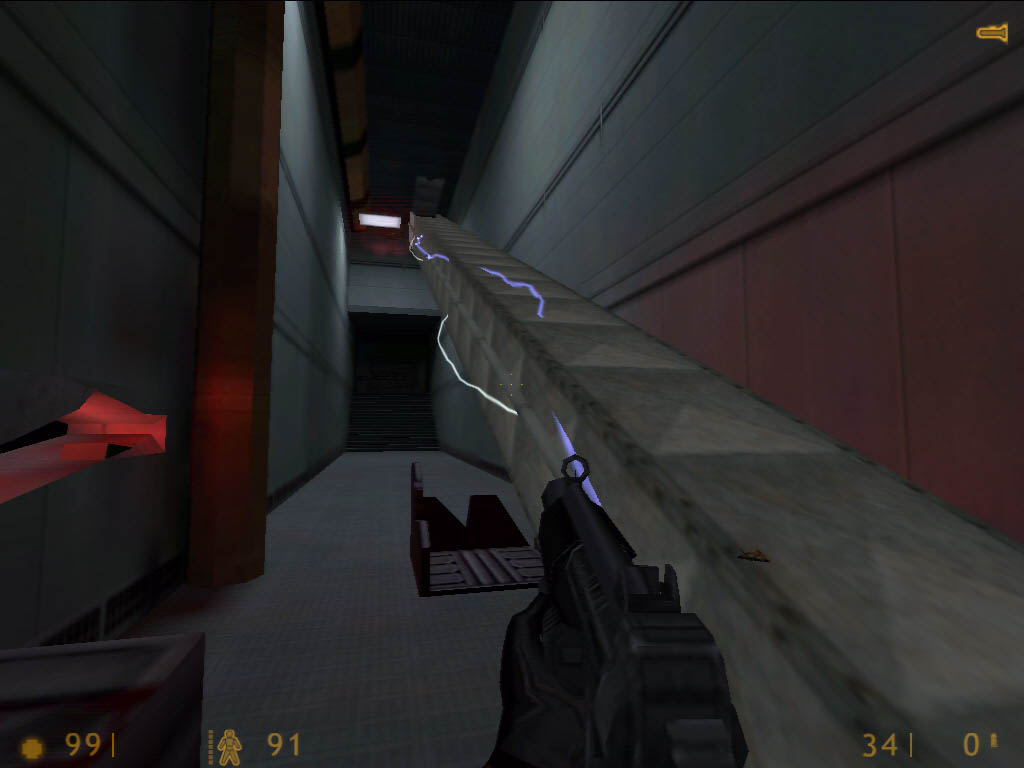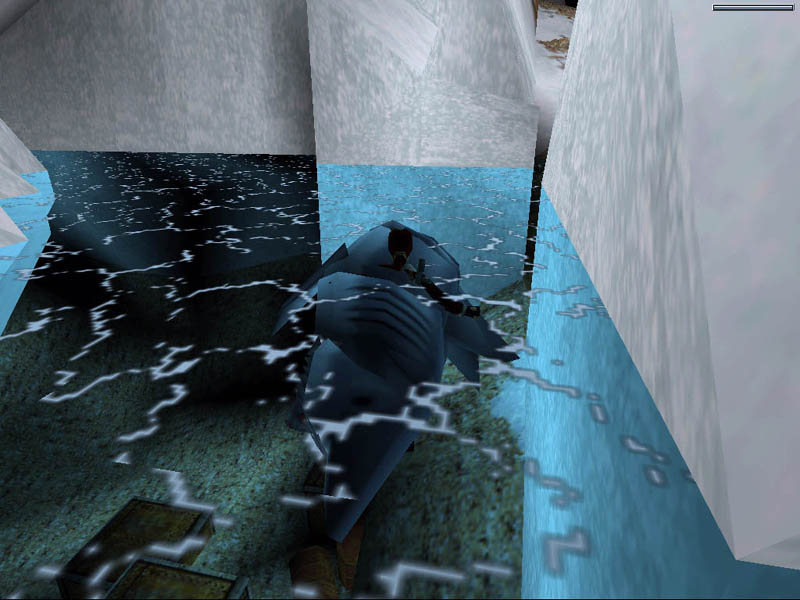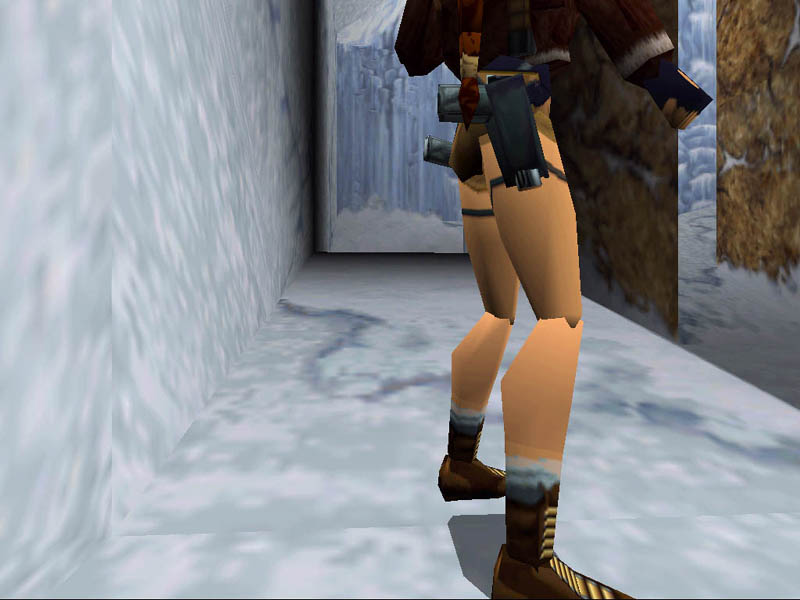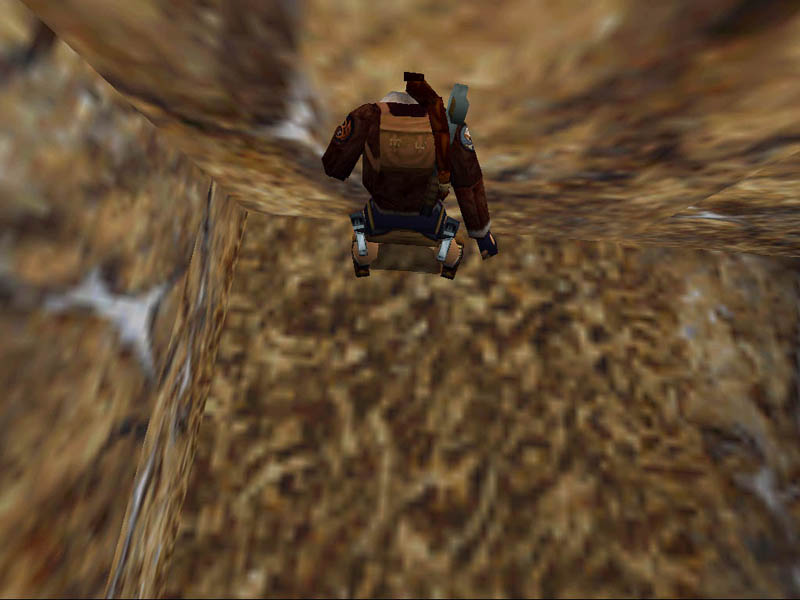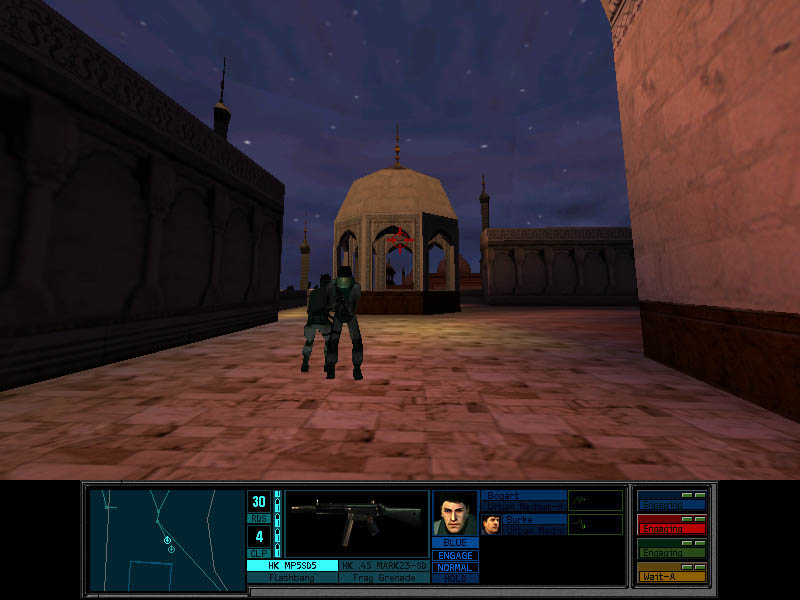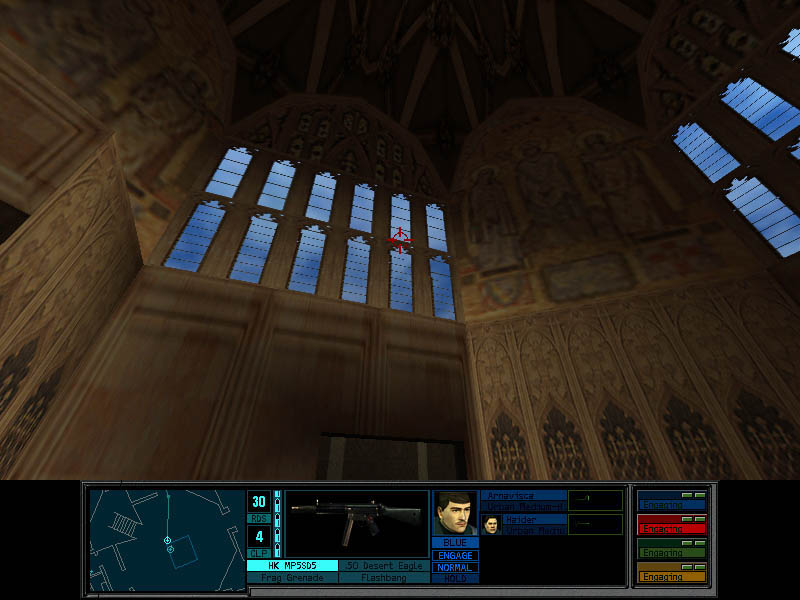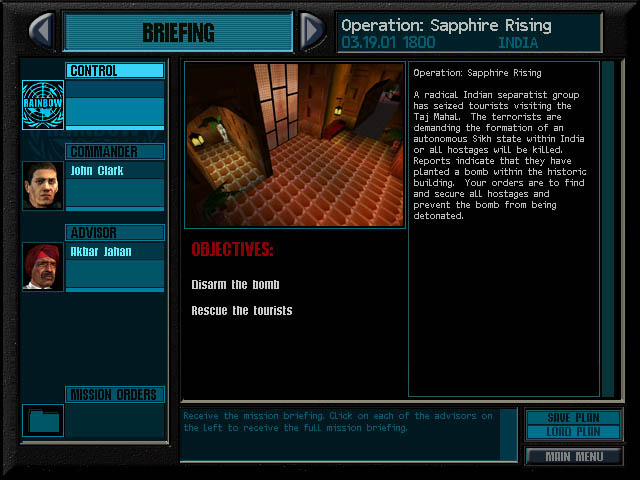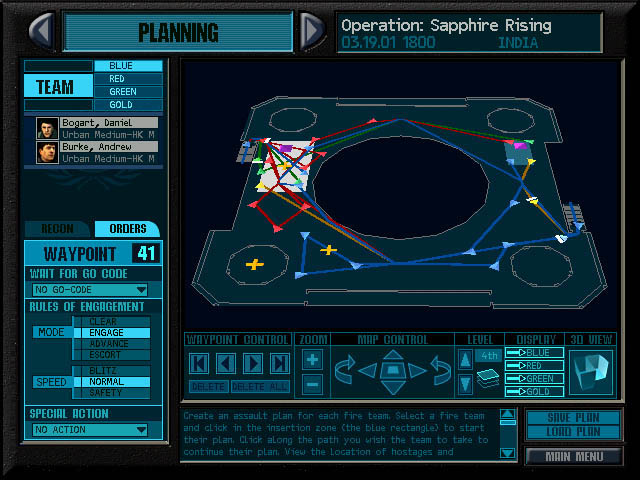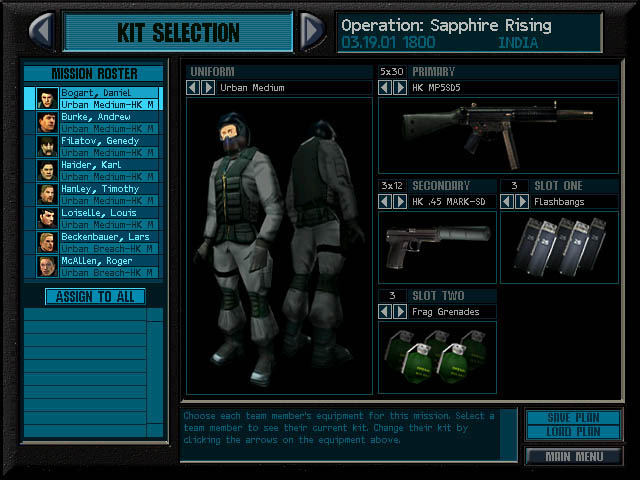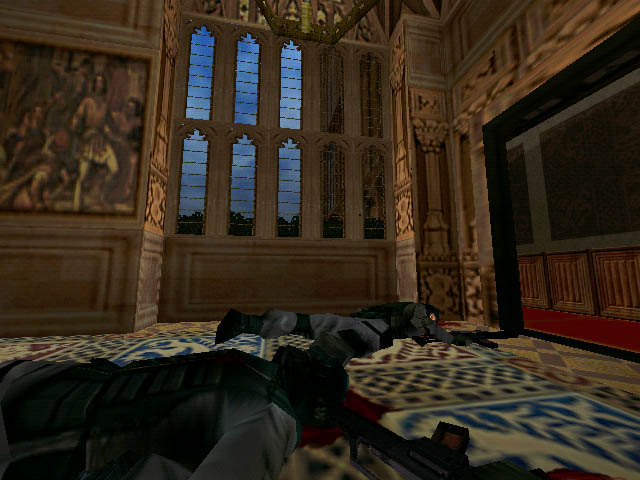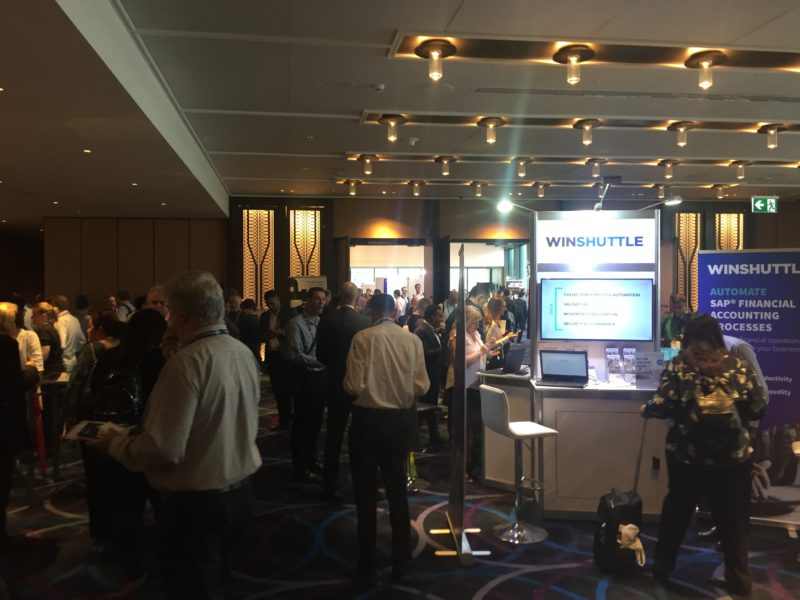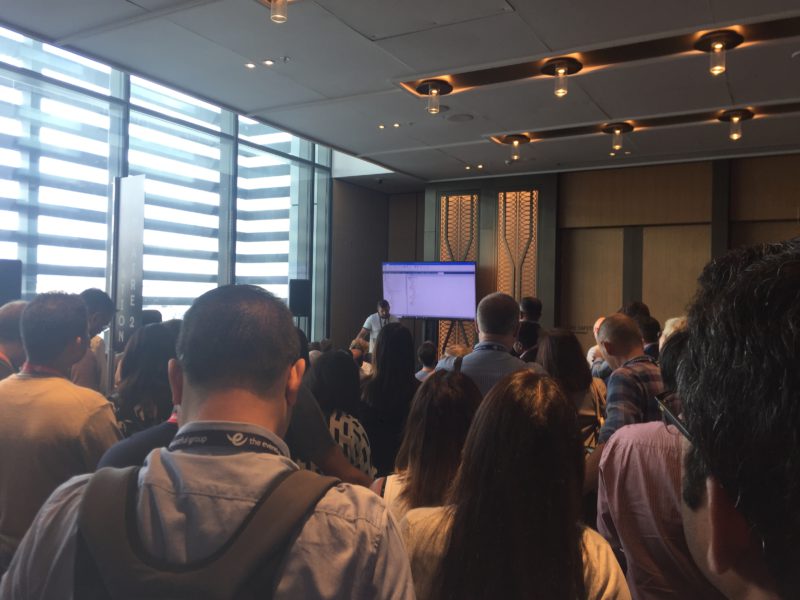Published on 3DGaming.net on 5 February 2000, mere months before I’d leave the world of gaming and enter the world of academia for a decade.
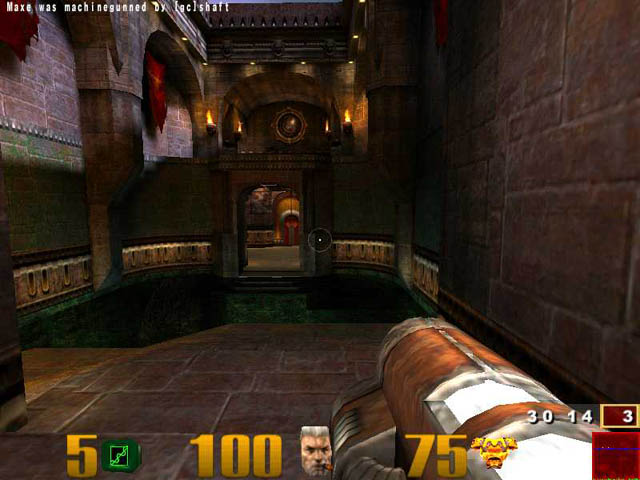
Concept
Ahh yes, the ever-venerated Quake series introduced the gaming world to 3D. And what yummy 3D it is. Too bad Valve owns yo—! (Editor’s note: The biased writer was executed. We have hired a new writer to take his place.)
It halted the progress of 3d gaming. Suddenly we all want to be a 3D shooter don’t we? After a superior sequel called, ironically, Quake II, id software returns for one more round of ‘The 3D Wars,’ now at your local newsstand.
Nearly two years ago id software announced it would forgo any single player experience at all (good joke guys!) for a completely multiplayer experience. After all the hype and all the speculation, Quake 3 Arena finally arrived on shelves. Original speculation was an all new type of multiplayer experience, where the design would be completely geared for an online experience. Online gaming had been done before with Tribes, otherwise known as perfection, but it was nothing of Quake 3’s standard, or fast and furious deathmatching.
John Carmack even admitted, it was a risky proposition, crafting an online only game. Of course, there are bots to practice against, but that’s secondary to a balanced online experience. Deathmatch has been done many times before, so id had to truly offer something new and intruiguing to make Quake 3 a fun product. That’s the least we ask for, the Bruce Willis equivalent of a videogame. Fast, loud and bloody. Sounds like my Friday nights.
I’m sure you’re wondering how to play Quake 3, and if you’re not then there’s something wrong with you. This is concepts and story! We’re going to tell you how to play Quake 3 whether you like it or not! Those who disobey get to sit in the corner with Romero and the Green Bay Packers.
What you want to do is this: Install the game, double click on Quake3.exe, adjust your settings and get online, then kill whatever moves that isn’t you. Or if you’re playing Team Deathmatch or CTF, kill anyone who doesn’t have the same skin color as you. Otherwise, frag away. Welcome to Quake 3 Arena. Deathmatch refined to its finest. I don’t know how deathmatch could possibly be refined anymore, but hey, apparently it needed to be.
The story can be summed up in only a few words: Ppfftt! Yah right!
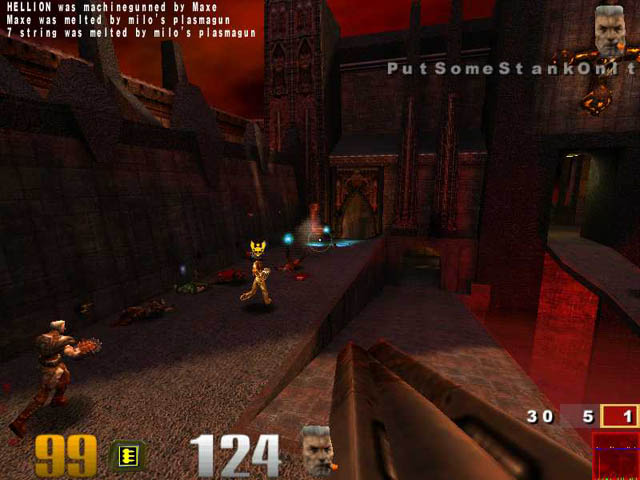
Does a multiplayer game really need a story? Think about it. When you are running around a map, firing rockets and spewing bullets at anything that moves, do you ever stop to think about the utterly captivating history or storyline of exactly what’s going on? Of course not. And id has never been the king of telling a captivating story either. But yet, id was determined to create the best storyline possible for the type of game Quake III Arena is.
There was some throwaway plot about alien abductions and Dean Martin’s pants. All this and more on next week’s Star Trek Voyager, The Teen Years. Actually, for the literate bunch of you, (Huh? A sentence? You mean those things with words?) if you ever bother to look at the Quake 3 manual, (which if you did, I’d laugh at you) you’d discover that there’s some vague plot about a gladiator, an arena eternal, a ‘We ripped off Mortal Kombat because our writing skills can’t even match that of a five year old,’ plot, lots of blood and gore, and in the end of it all, some Philosopher-cum-rocketlauncher toting mass murderer named Xaero. And don’t forget, this is all a sport. Much like herding sheep. Except sheep can’t fire rail guns, and if they could, well, they’d have to be some pretty durn special sheep.
The manual also has a short description of each character in the game. It would have been nice to see a little more, but then, this is a multiplayer game, so my expectations aren’t exactly very high. Actually they’re about as high as the dirt on the ground. After all, this is id we’re talking about.

Gameplay
Three words: Fast and Furious. Quake 3 is like the best National Lampoon flicks. Of course, Christmas Vacation is the best of them all, and Quake 3 came out right before Christmas. Ofcourse, it’s all cooincidental. It has to be. Now if only there was a Griswald family skin set, then Quake 3 would tower amongst its competitors. The gameplay seems to be a mesh of Quake 1 and 2 for the most part. Prior to Q3’s inception, the Quake scene was divided into two halves: those who played Quake 1, and those who played Quake 2. Now there comes a third group: those that play Quake 3.
Quake 3 shipped with several modes of gameplay: Free for All, Tournament, Team Deathmatch and Capture the Flag.
Free for All: otherwise known as deathmatch, needs no introduction. Id is the father of deathmatch as far as I’m concerned and will always hold the reigns of the wheel.
Tournament: 1 on 1.
Team Deathmatch: I actually found this to be surprisingly fun. I’d never played team dm prior to Quake 3 and it’s actually pretty damn daft!
Capture the Flag: As if this needs an explanation? Steal the other teams’ flag dumbass!
On a personal note, in regards to Tournament mode, being 1 on 1, I don’t recommend loading up large maps for an obvious reason: the match will last a lifetime.
Now that we know what the modes of play are, let’s talk about the maps and then the weapons.
Deathmatch Maps
Q3DM0 – Introduction: A fairly small map, good for about 3-5 people playing FFA or Tournament.
Q3DM1 – Arena Gate: Good for ffa’s, this map is good for a group of about 5-6 people. Make sure to stop by the big tongue at the back of the map for a truly disturbing experience.
Q3DM2 – House of Pain: Wow. This map simply rocks. 10 + people in this map is all out chaos. An awesome dm map. Cheers to the id gang for this map.
Q3DM3 – Arena of Death: Decent map. Good for about 6 players in ffa mode.
Q3DM4 – The Place of Many Deaths: What an awesome map. One of my favorites in Q3, this map is a blast with about ten people in it on ffa mode. Props to id.
Q3DM5 – The Forgotten Place: What can be said about this map other than ‘chaotic’? One half Giger-ish space trash, one half heavy metal. Add 5-6 people, ffa and stir.
Q3DM6 – The Camping Grounds: Awwww, I cannot say enough about this map. You don’t forget great designs such as this. The Camping Grounds is an awesome display of superior map design. There’s nothing like playing this map with 10 people and Paradise City by GnR blaring from the speakers. Q3DM6 is a classic ladies and gentlemen.
Q3DM7 – Temple of Retribution: One of the infamous test maps. A good map with one weak flaw – the rocket launcher is a blatant camping spot. If you hate campers (like my editor, that filthy bastard Rick) then I’d skip this map. Good for about 7-8 people in FFA.
Q3DM8 – Brimstone Abbey: I knew a girl named Abbey once. Nice girl. Bad temper though. Brimstone, incidentally is also one of the (at the time of this publication) four ctf maps, with more to be released soon by Disruptor (Christian Antkow). 5 on 5 – 6 on6 in CTF or Team DM can get pretty intense. There are some odd dead end rooms that are fun for an easy kill. On an unrelated note, if you get a chance to stop and observe the arches in the main room with the plasma gun, stop and do so. If I didn’t know any better, I’d say that someone has been studying medieval architecture over at id. Fun stuff. The nice use of reds and blues throughout the level is also a nice change from the ever persistent brown and gray palette.
Q3DM9 – Hero’s Keep: Acceleration pad madness. I’ve had more than one fall to my death due to smacking right into someone else mid air on my way to gank myself a rocket launcher. I’d keep the number of players low due to the large number of ‘deaths by pitfall’ that can occur. 5-6 players in FFA. Also a fairly decent Tournament map.
Q3DM10 – The Nameless Place: You got that right. This map has a cool scifi design reminiscent in some spots to aliens with tight and electronically lit corridors. Check out the blue… thing up on the stairs near the mid hallway. It looks like someone broke the teleporter thing from Trek and got it stuck on permanent. A good ffa and tournament map, nice and tight. Good for about 4-5 people in ffa.
Q3DM11 – Deva Station: What a cool map! Just getting the quad is a challenge! Retro is the only way to describe this whacked out map. In some spots it truly feels like an arena, with arena lights up above and everything, and in other rooms it has a space station-ish feel. Like I said, retro but still damn cool. There’s no one theme, but in this case, it doesn’t matter. For FFA this map simply rocks the house. 10 people in this map is a mad rush.
Q3DM12 – The Dredwerkz: If I could rename this level, I’d rename it to ‘BFG: Frantic!’ because of the awesome amount of chaos that ensues when someone gets their hands on the armor, quad, bfg and an assload of ammo. Dredwerkz is a madcap rush of enormous heights, pitfalls, jump pads, acceleration pads, teleport pads and devastating weapons. Load this sweet bitch up with 10 people on FFA and set the timer for 20 minutes. You’ll thank me.
Q3DM13 – Lost World: Remember that killer mpg that was released around the time that the whole ihv incident went down? Remember the cool living orange pillar in the video? Well, it’s here folks! It may not be the main attraction of the level, but it’s still a cool side show attraction. A cool map nonetheless, DM13 is a feast of gibs with 7-8 people getting the smack down on each other in ffa.
Q3DM14 – Grim Dungeons: Sadly, this map isn’t very memorable. There’s nothing that really makes this map stand out other than the surprise near the lightning gun (let’s just say it might offend some people) that I found to be cute. It’s not a bad map, but when compared to the likes of Q3DM2, it loses any sway it might have held over me. Good for about 7-8 people in ffa mode.
Q3DM15 – Demon Keep: Truly a bizarre map, Demon Keep is an immense amount of fun with 10 people blasting away in ffa. Thrown into the map is lava, acceleration pads, jump pads and the rail, making for a wildly fun map.
Q3DM16 – The Bouncy Map: One part ‘The Longest Yard’, one part maze. All parts fun. A decent ffa map, If more time was given to expand this level, it could have been a fierce ctf map. As it stands, it’s a decently fun ffa map that’s enjoyable with 7-8 people.
Q3DM17 – The Longest Yard: One more infamous test map. And also one of the best. This map stands as one of the most frantic with 10 or more people in it. There was some picture on planet quake of a triangle of bodies piled atop one another some time ago that captured my point beautifully. This map shall not be forgotten. FFA with 10 + people is the way to go.
Q3DM18 – Space Chamber: Tall arches and sudden drops into a bottomless black abyss. What more could you ask for? Props to mic for kicking my ass on this map a few days ago. The addition of jump and acceleration pads makes for an experience not to be missed. To the designers of this map: the addition of Matrix-esque gravity could only enhance this already amazing map.
Q3DM19 – Apocalypse Void: Let me get this out of the way right now: I hate this map. It is the most sadistic map I have ever played. I have this theory that I’ve developed that the map designers of Apocalypse Void wanted to induce a feeling of motion sickness combined with anger and frustration so they created this map.
Of course, this probably isn’t a very popular theory. I actually consider this to be a great team dm map simply because I can imagine people taking a large amount of pleasure in knocking their teammates off the sides of floating pads and sending them to their deaths on a very hard surface. With 8-9 people in FFA or team dm is an enjoyable time. Also good for a tournament match.
Tourney Maps
Q3Tourney1 – Powerstation 0218: Blah. A somewhat bland circular map. Nothing outstanding about the design here outside of the consistent use of a purple palette. For 1 on 1’s this is an ideal map, but only for 1 on 1.
Q3Tourney2 – The Proving Grounds: Ahh, one of the infamous test maps. This map sports a spectacular design. The map in one half divides itself into two floors and in another into a tall roofed corridor near a teleporter. Sprinkle with a dash of lighting gun and fog of death and let simmer. A well rounded map that is immensly enjoyable with 10-15 people. Team FFA all the way on this map.
Q3Tourney3 – Hell’s Gate: A moderate sized map, this one feels more at home in a pure dm match than anything else, although it’s small enough that a 1 on 1 match wouldn’t be out of the question, but for ffa I’d stick to 4-5 people at most.
Q3Tourney4 – Vertical Vengeance: The style of this map seems very similar to Q3DM11, which may or may not be incidental. Nonetheless the map design is still solid and stands out. This is a very cool map to get about 8-9 people into for FFA or team dm.
Q3Tourney5 – Fatal Instinct: A remnant of the ihv as someone on the Quakeworld forum (I think) mentioned was originally named Tim1 for those of you that had it. I can’t say I think too highly of this map due to the frustration that ensues due to the piss colored peasoup fog. I can’t say I’d recommend more than 8-9 people for this map due to the frustration that I’m probably not alone in sharing with this map. With a little work, this map could have been improved upon greatly.
Q3Tourney6 – The Very End of You: What an awesome 1 on 1 map! Awwww, this just needs to be seen to be understood how awesome it is! This is a first: Floating mazes. It’s like a combination of ‘The Longest Yard’ and ‘ The Bouncy Map.’ This map is also one of the few I can find that makes use of the oft mentioned reflective surfaces that Quake 3 was supposed to make use of.
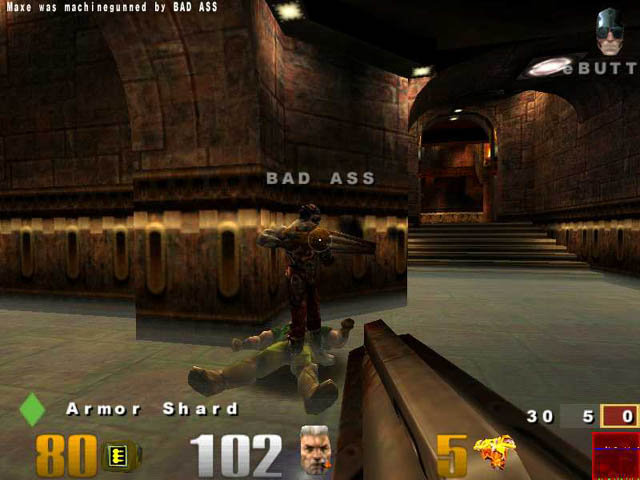
CTF Maps
Q3CTF1 – Dueling Keeps: Very simple layout, blue and red teams, nothing out of the ordinary. It reminds me of a few ctf maps from Quake 2 for some niggling reason. The map itself doesn’t really stand out in any amazing way other than it just works. One of the cool little options in this map is to jump through the windows besides the doors in the large corridor between blue and reds’ sides, which is especially useful if your teams happens to be rushing or blitzkreiging.
It’s not an enormous detail, but then, it’s the small details that can really make or break a game. I personally like this map a lot and prefer it over all the other ctf maps. A good sized game would be 5 on 5 or 6 on 6. Anything larger and it would become frustratingly difficult to capture the flag.
Q3CTF2 – Troubled Waters: I’m really not too fond of this level. The corridors wind around a bit too much for my tastes, plus, incidentally, the main throne rooms where the flags are held are somewhat similar to the main rooms in Brimstone Abbey, which is somewhat unusual. A fair sized map, I’d recommend about 5-6 players per team. The water is pretty daft too. Check out the skeleton chillin’ in the water. Pretty cool stuff.
Q3CTF3 – The Stronghold: Meh. Another map I didn’t really take to too much. Y’know, I can understand id’s wanting to ship four quality ctf maps instead of eight decent ctf maps, but only ctf1 really captures my attention. The stronghold is a map that could be a great deal better if it was stripped down to its barebones. As it stands there’s one main hall way where big fights should take place but never really do. It might be because there’s too much open space in the map, but I could be wrong.
I do gotta give props to the sound guys over at id for paying attention to little things like the sound that comes from walking on metallic walkways as it actually adds to the dark atmosphere of the map. This may not be an outstanding map, but it’s not a terribly bad one. Teams of 6-7 are about adequate for this map.
Q3CTF4 – Space CTF: This map earns the honor of being named the most fu%*ed up CTF map I have ever seen. The combo of The Longest Yard and CTF, not to mention portals is pretty damn funky. It’s not your typical map, but it gets the job done. The only real problem presented with this map is lag. One wrong move and you’re bacon. The presence of the railgun only heightens tension. A fair sized amount of players is approximately 6 players to each team for this map.
Remember, there’s no grappling hook. Yes, I too cringed at this. The grapple is such a staple of all the things that defines the Quake series.
Now that we’ve talked maps, let’s talk guns, because we love guns. Guns are our friends. They make us laugh, they make us cry, they make us blow the living sh*t out of one another.
Most of the weapons in Quake 3 are weapons seen in the previous two Quakes, but let’s run down the list together anyway.
The Gauntlet: Whirling saw blade + electrical charge = a “humiliation” (award) on anyone stupid enough to get sucker punched by this badass mofo. Everyone starts off with this weapon that also requires no ammo. Each hit from the gauntlet does 21 points of damage.
Machine Gun: Although not the most powerful weapon, it has a high rate of fire. Each direct shot does 7 points of damage.
Shotgun: The shotgun is a useful spread weapon with a short reload rate. Up close the shotgun is a lethal mofo. It does less damage the further away you get. Testing the damage spread on apocalypse void, 3DGN’s artist Dave Myers and I experimented with the damage of the shotgun on the main platform of the map. At point blank range, with 100 hp and 0 armor, a point blank shot will kill you. At a medium distance (about 10-20 feet away) it does 58 damage and at a large distance away (about 30 feet away) it does 10 dmg per shot.
Plasma Gun: Aahhh, one of my favorite weapons. Having 100 shots, armor, megahealth and quad and going on a rampage with the plasma gun is what it’s all about. Releasing a torrent of plasma pulses upon opponents, the plasma gun is one of the three ‘room cleaning’ weapons. Each plasma pulse at any distance does a total of 6 damage.
Grenade Launcher: Once again, personal preference prevails. I liked the Quake 2 grenade launcher a great deal more. It had a better feel to it. The grenade launcher in Quake 3 has a wide blast radius and each grenade that doesn’t hit point blank and ends up bouncing around has a timed fuse, which can be useful if you’re trying to get out of a packed room and want atleast one easy kill. A direct hit from a grenade at 100 hp and no armor will kill you. End of story.
A direct hit with 100 hp and 50 armor will take you down to 50 hp and no armor. Someone from id mentioned a while back that the grenade launcher had a blast radius. What the exact mathematical calculation is, I don’t know. After having tested it out though, I’ve come up with these numbers: standing right next to a lobbed grenade when it explodes will take off 52 hp. Moving away about 2-3 feet will take off 37 hp.
Rocket Launcher: The rockets fired from the rocket launcher can not only do direct damage, but also splash damage due to their blast radius. A direct hit from a rocket with only 100 hp and no armor will kill you, so I recommend wearing armor at all times.
Lightning Gun: Making a return appearance from Quake, it’s the lightning gun! Of course, with time, it’s now changed. Now the gun discharges in water, as opposed to the original Quake, where, if you fired it off in water it was because you had a death wish and a desire for death. Water + Electricity = death. It’s that simple. The laws of physics must be maintained if there is to be order in the universe! Despite this niggling bug, the lightning gun remains one of the coolest guns in the game. Each shaft from the lightning gun does 16 points of damage.
Railgun: Making a return from Quake 2 is the mighty railgun, god to the masses. The speed seems to have been increased ever so slightly, although I could be wrong on this. Quake 2 had a really cool swirl effect that’s been eliminated in favor of a twig like laser beam. Bleh. Where’s the radical effect? Where’s my swirl god dammit? The damage on the rail is a straight unconditional 100 hp. Unless of course you’re wearing armor. 100 hp and 50 armor after a direct hit by the rail will be taken down a notch to 50 hp and no armor.
BFG-10k: You know, I really miss the old BFG-2k. After that, this new BFG just feels underwhelming. I’m probably not alone in this feeling. The BFG-10k fires off massive balls of plasma at your foes. Hmm, sounds like a certain other weapon in Quake 3. For all its vaunted power, the bfg is nothing more than a rocket launcher with a faster firing rate. A direct hit will do 100 dmg. With 100 hp and 50 armor you’ll be knocked down to 50 hp and 0 armor.
So those are the maps and weapons. How do I feel about them? Well, I certainly miss the old BFG. Not having a second firing option also detracts from the game, since secondary firing modes have become a norm in gaming. And I certainly wish there had been more ctf maps to play with. But then again, the grapple could really hurt the gameplay in Q3CTF4, so I can understand the omission of it from the game. I love Q3CTF1 though. It is a kickass map of the highest order. The dm maps are various enough and range from stunning to mediocre, which is expected. You can’t please everyone.
On a side note, I’d like to make the note that Quake 3 should be officially renamed to Descent Quake3. Why? When you shoot at doors, they open. I’ll leave it at that.
Throughout the levels be on the lookout for various powerups:
Green Health: Each cross adds five points of health.
Yellow Health: Each cross adds twenty-five points of health.
Gold Health: Each cross adds fifty points of health.
Flight: Do I really need to explain this?
Haste: Accelerates your movement and firing rate.
Invisibility: Duh.
Megahealth: Adds 100 points to your health.
Quad Damage: Your weapon damage (as opposed to your breath) is multiplied by four.
Regeneration: Your health is regenerated until it reaches 200 or the time limit runs out.
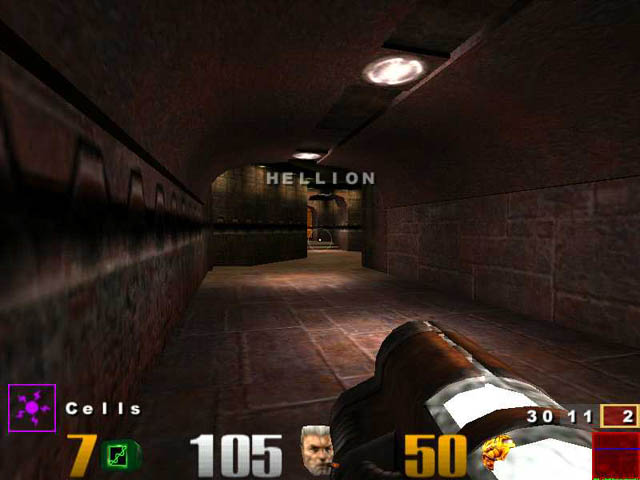
Graphics
Quake 3 is a pretty game. In fact, Quake 3 is a very pretty game. Between the levels and models, I’m in awe. To the id team, guys, I tip my hat to you. How do you work your magic? Do you tie Carmack down to a chair and force him to work at gunpoint? I always imagined that the id offices would be populated with gordeous women clad in black leather that would motivate staff to work through whatever means necessary, and if that means getting whipped, then by all means, whip away!
You will need a ‘Class A’ accelerator to run Quake 3, as it is a visual feast. I envy GeForce users. What needs to be said that hasn’t already been said? Curved surfaces, heavily detailed models, gordeous smoke trails, and in 3Dfx’s offices, motion blurs. Not that that we care about motion blur, right guys? Right? Guys? Uhhh, guys?
The graphics are certainly outstanding. Shadows fall upon corners with rotting skeletons and heads of programmers, arching tunnels lead to pools of lava, and the water ripples when jumped into. It all looks quite nice. But it’ll also take a hog of a system to run it all. The minumum requirements are as follows:
– A Pentium 233 XXM with an 8 mb video card
– Pentium II 266 with a 4 mb videocard
– K6-2 350 with a 4 mb videocard
– 64 mb of ram
I feel like these system specs should be in a Penny Arcade cartoon where the entire strip consists of Gabe and Tycho laughing at the system specs.
I don’t know how Activision expects to be taken seriuosly by publishing these sorts of things on the side of their boxes. Technically speaking it’s feasible to play the game with such a lack luster system, but you won’t be seeing much of the game. Maybe a few outlines and a flare here and there. Other than that it’s a lost cause.
If you want the specs for a system that will crank out the fps like Sweet Dick Willy on Friday night at TGIF’s, you’ll want alteast a 400 mhz cpu, 128 mb of ram, a TNT1 or 2, GeForce, or Voodoo 3. On my system, which is a 400 mhz system with 128 mb of ram and a voodoo 3 3000, I have an average fps of approximately 30 at 800 X 600 with textures set to 32 bit color, which does actually help, bilinear filtering (enabling trilinear filter just kills the framerate) with textures set at approximately 4/5 their full detail.
There’s a great deal of graphical options that can be enabled using cgi commands not included in the menu options. Remember that you’ll want a powerhouse system to enable things such as shadows. An interesting option presented is the ability to set the detail level to fastest, fast, normal and user defined in the options menu.
The newest incarnation of Quake sports the hyped feature known as curved surfaces. Does it look good? Hell yes. Does it change the game any? No. Once again id uses a palette of mainly brown textures, which begs an important question: is id software colorblind? This is one of the few qualities that upsets me. How many times am I going to play through the same environments again and again? Prior to Quake 3’s release we were all hearing about how we’d be seeing mirrors used prevalently in Quake 3, as well as portals that would allow players to see through to the other side of them.
What did the final product reveal? A combination of Quake and Quake II with improved graphics. Whoopee. Do I get a discount for having purchased Quake I and II? The architecture of Quake 3 is absolutely stunning, but suffers due to sequelitis. Id has been there, done that, so to speak. Dank goth castles with satanic references (which way are those pentagrams pointing anyways? Cause if they’re right side up, they’re not satanic.) have been done to death.
Please, move on. I saw this same design back in ’95. I can hardly tell the difference between the two. Yes, I’m biting with sarcasm. Now you know how my editor felt when he had to review the demo for TombRaider 4. What I’d really like to see is a map of id software’s offices. And John Carmack’s cars if possible. I’ve been looking into investing in a temple of worship for the almighty Carmack.
However, as much of a technological achievement the Q3A engine might be, it took id Software nearly 2 years to reach the power of Epic Games own Unreal engine. And even now, the Q3 engine is still lacking in a few areas. So although the game looks good, it doesn’t actually push any technological limits how Unreal did nearly 2 years ago. But that doesn’t stop this game from bein prettier than a swank chick at a nudie beach. And we all know how fun nudie beaches are.
While I’m on the topic of graphics, let me talk about the models. In the words of the 3DGN homeboys: Eye wub j00 guyz! Paul Steed sir, I worship thee. For truly thou art a god. You and Frank Miller. There’s a certain nostalgia feeling that’s brought up when I see the Doom guy run around killing everyone in sight. I’d like to dedicate a song to you, oh wonderous Doom guy, it’s called ‘Oh Wonderous Doom Guy.’ Original eh? ‘Oh Wonderous Doom Guy, How I love thy lucious rocket launche–. (Editor’s Note: We’d like him to stay on topic as much as you would.)
Cinematics
You’re kidding right? Cinematics? For Quake 3? That’s about as necessary as an enema. Ewww. They’re still cool to watch though, as brief as they may be.
Paul Steed noted in some bulletin board over at Quake World ages ago how he spent some time cooking up a video of his Cable inspired character Sarge. They’re not fmv. There’s a tiny video for every character that you the nameless player must face in a series of tourneys. Outside of that, I quote gamespy on their summarization of the plot for Quake 3: “Ppfffftt.”
They’re well made and look really cool, but they don’t offer much. In or out it wouldn’t change the game in anyway. Nothing much to be said here. I usually just hit escape to skip right past them.
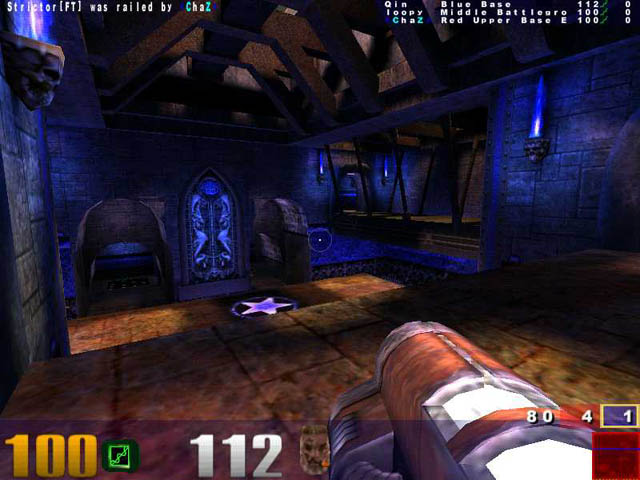
Sound
Apparently some time ago someone decided that redbook audio was dead and that all music from now on was to be played in the form of mp3s, as utilized in Wheel of Time and the upcoming (no really!) Daikatana. Unreal used umx format files. Both Quake I and II shipped with the music on the cds. Quake 3 on the other hand does not.
Instead within the pk3 files are several wav files by Front Line Assembly and Sonic Mayhem. It gets better. Now we have to purchase the soundtrack. No longer does it ship with the game. Oh no. We have to pay more. Lovely. At least Romero has the decency to ship his game with the soundtrack in mp3 format.
Welcome back Sonic Mayhem, we have missed thy presence. Lemme tell you something folks, the Quake 2 soundtrack is very freakin’ good, so upon hearing that Sonic Mayhem would be returning to score Quake 3, I immediately became excited. And then I heard the bad news: electronica shall be present. Oh joy. Nevertheless, I remained optimistic that the music would be good, since electronica can range from excellent (anyone remember the music from the opening scene in Blade?) to absolutely horrid (everyone on mp3.com. Get off my planet!)
What I found instead in Quake 3 was a mix of rockish metal and ambient sound. Thankfully I was spared the pompous voice of some “I hate life and wish I was dead,” psychopath who screams into the mic and blows speakers wherever he goes.
As for the regular sound, there’s an option for high and low quality and the option to enable A3D, which upon enabling will absolutely kill your frame rate, so I don’t recommend enabling A3D. EAX is not supported out of the box (read: EAX users got the shaft. Don’t you love independent developers?)
Outside of that, it’s nothing special. Copy and paste sounds from Quake I and II and it’s pretty much done. All returning weapons have if not the same then nearly the same sounds as heard in Quake I and II. Yawn. As for footsteps, they’re there, but it’s nothing spectacular. There’s a footstep sound for regular ground and for metallic ground, but does it really matter in the heat of a firefight? Either way you’re going to die, so you might as well come to accept your fate, and if you don’t like it I’ll spork your ass!
Interface
Hahahahaha.
I feel sorry for whoever designed the interface for Quake III, cause he’s going to get ripped apart by the press. And I think he deserves it. I’ve never seen such an outright sloppy interface. I want a GUI with options. Not a cool logo at the top that allows me a minimum amount of options. It’s as though someone through it together at the last second. The fact that it required a mod maker to fix the multiplayer screen is a sad statement about developers in today’s world.
I want to be able to adjust the size of overlays, of every single last control instead of having to manually edit a config file. Everything should be adjustable. None of this cgi nonsense. If I wanted to learn code I’d go to programming school. Three things must be remembered First of all, Built in server browsers should be neat and organized. Second: Tabs people, tabs! Gamespy uses them for a reason. Take a hint. Third: GUI.
So what did I like about it? The basic options are there. And id did want people to be able to get into the game in three clicks, but did they really have to skimp on design to do so? I think not. And for goodness sake, auto downloading people!
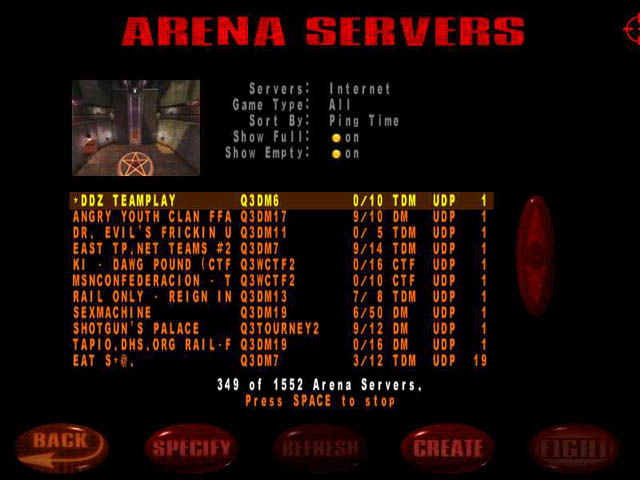
Multiplayer
Deathmatch. Team deathmatch. Capture the flag. Tournament. Three out of four require you to turn your brain off. And the fourth, CTF, consists of all of four maps. This is like Clam Chowder. You gotta have the crackers. Without the crackers, the soup just ain’t as good. Manufacturers don’t ship just one or two crackers, but a multitude of them of all different shapes and sizes.
Quake III’s soup shipped with four crackers. It didn’t turn out to be a very good meal. I just made a metaphor to food in a videogame review. That has to be a first. Do I receive any kind of award for being the first?
To understand single player mode, just think: Mortal Combat. And no, I don’t spell it with a k, because that’s improper spelling and my editor won’t stand for that. Don’t you know your grammar?
Let’s talk about the bots first. I’d break down laughing if I wasn’t expected to be taken at least mildly seriously for a part of this review. Prior to the release of Quake 3 the gaming community had been told to expect life-like bots. Well first off, the single player mode should be renamed to ‘Fight The Talking Bot,’ as they are just about the most annoying gaming experience yet seen. Who the hell talks during a match?
I don’t mean snide little remarks such as “You suck Sabre!” but rather, full blown sentences. These guys have mouths that run a mile long. Klesk is one of the more annoying ones. Throughout matches with him he’ll talk about how he wants to eat you. Is this a game or a gourmet buffett? This is what ‘Auto Taunt’ exists for. The bots levels range from ‘suck ass’ to ‘kick your ass’ levels. At nightmare mode it’s absolutely impossible.
Lan-play is also quite smooth, as always. Reports from users on dialup range from “ok” to “horrid.” It really does depend on your isp how well the game will play. Regardless of that, the game is quite smooth over the net, since that’s what it was intended for.
Single player is also included in here, if you really want to call it that. Deathmatch is just what you’d expect it to be: Run around and kill everyone else. No real surprises here except that it plays out like the best of Quake and Quake II.
Team Deathmatch: Uh, yah. Why not just add a flag while you’re at it, since that this is simply Ctf without a flag.
Tournament: This mode is actually quite fun. Matches are one on one only, so wait your turn, although no map is limited to one set mode, so Q3Tourney1 can be played as DM, Team DM and Tournament.
CTF: The weakest mode in the game. The general stance seems to be that Q3CTF1 and 4 are the craptastic maps and Q3CTF2 and 3 are the well designed ones. I enjoy them all myself, but the main problem is just that: there are only four maps. I’ve already heard the argument that ‘We didn’t want to ship 8 or so decent quality maps when we could ship 4 great maps.’ Let the fans decide bub. This is a game aimed at the fans, and in this case, less is not more.
I’ve heard rumor that a certain thematical design was intended for Quake 3. You mean Creepy castles and futuristic landscapes? Yah, we’ve all seen it before. Just give us all the maps you’ve worked on. There are a total of 29 maps in Quake 3. That is not nearly enough for four different modes of gameplay, especially when fans will find themselves sticking with a certain 3 or four maps all the time, as players did with the Q2DM1 – The Edge.
Multiplayer games can be found by simply clicking on the multiplayer tab, which will allow you to sift through local games (meaning LAN or node system for Cable isps such as my own), M-Player (which annoyingly installs itself on your hard drive when you install Quake 3), and regular servers. If you want to join a server while the list is refreshing, simply hit the space bar and click on ‘Fight!’ and you’re on your way.
The one minus to the multiplayer is that there’s no auto download as there was with Quake 2, so if you don’t have a map listed on a server you’re automatically kicked back to the main screen, rather than told that you don’t have the map. It’s a slight annoyance that should be eliminated, much like decaf.
Conclusion
So how do I feel about Quake 3?
Nearly two years ago PC Gamer pimped id and Quake 3 with a world exclusive. The promises excited me, as did the really funky screenshots. The designs were old hat id, but it was still more interesting than what the final product produced, which is a mishmash of gothic castles and science fiction settings. But that’s what id does best, so who’s to complain? Those who were looking for innovation, perhaps.
When it comes to deathmatch, it doesn’t get any better than this. The visceral rush of Quake 3 deathmatch is unparalled. But outside of that and team deathmatch, it’s somewhat lacking as a stand alone product. The Quake series keeps itself alive through it’s fans and the mods they develop. I’ve always found it somewhat tasteless to let a community complete a game a developer could easily have made great. Only now are new ctf makes being released, and mods such as Team Fortress Quake 3, LMCTF for Q3, Rocket Arena 2 and more.
In the nearly two years that id spent working on Quake 3, it could have been very easy for them to comple a variety of different mods into Quake 3 outside of deathmatch. There was some development of this occuring, otherwise the gold edition wouldn’t have shipped with ctf maps. But as Paul Steed said in a post on the Quake World forum, Quake 3 Arena was to be a pure deathmatch title only, and certainly, in that respect it’s done it’s job. But I can’t help thinking that it feels a tad bit incomplete nonetheless.
If you’re a fiend for deathmatch, you won’t find much better than Quake 3. But if you’re a gamer who enjoys a variety of online combat, look elsewhere, because Quake 3 is nothing more than a reiteration and an unneccessary refining of the Quake series. Quake 3 is like the equivalent of TombRaider 3 to me. It’s all been done before.
That’s the problem. There’s nothing new here. All the weapons we’ve seen before in one variation or another, with the exception of the gauntlet. Some of the maps look like direct descendents of Quake and Quake II. There are even models brought back from games past. It’s like the Generations Mod with a new engine. Despite that, Quake 3 is one of the finest 3d shooters on the market and should not be overlooked, despite its flaws. You may pass by one of the most enjoyable games you’ll ever play.
The Goods
Quick Peek: It’s Quake. Again. This time purely multiplayer. Same game as Quake I and II, but with a new engine.
Pros: Stunning deathmatch. A variety of skins. Some of the maps have awesome level design. A new engine.
Cons: Everything else. Shoddy ctf. Repetitive map design that’s been seen in the previous two Quakes, feels rushed, laughable interface. No grapple in ctf. No code to play with upon release. No EAX support. Annoying bots. Lack of innovation.
Value: Been there, done that. Unless deathmatch is the only type of online gaming you do, this just isn’t worth your time.
Grades
Concept: B+
Gameplay: A
Graphics: A-
Cinematics: B+
Sound: B
Interface: D
Multiplayer: A
Overall: A-

